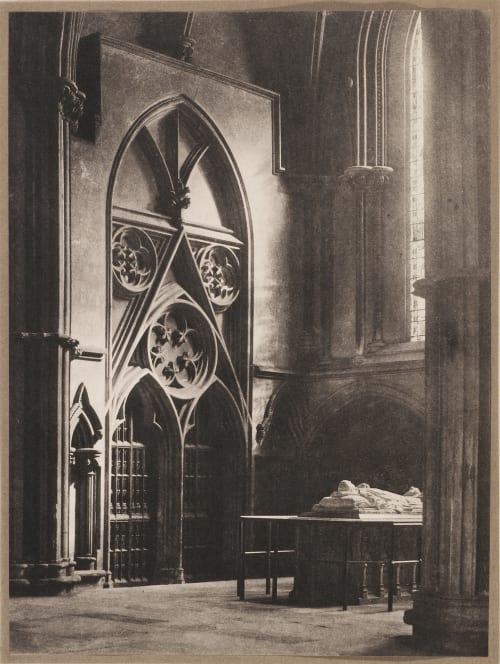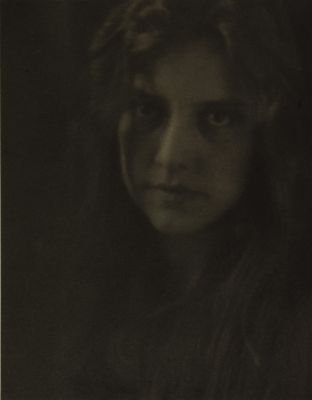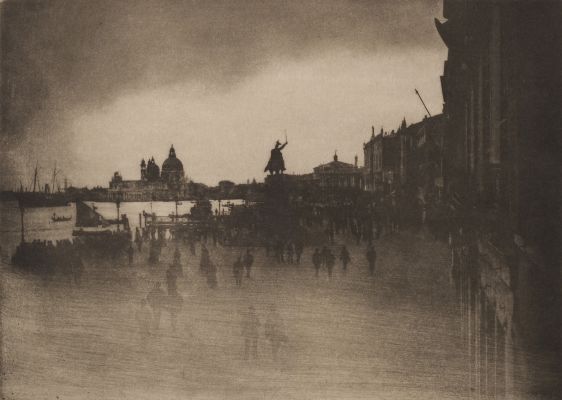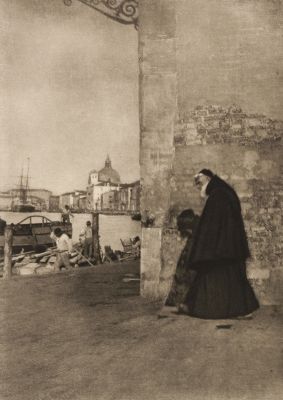
Title
In Sure and Certain HopeArtist
Evans, Fredrick (British, 1853-1943)Publication
Camera Work VIIIDate
1904Process
PhotogravureAtelier
J.J. Waddington, LondonImage Size
19.9 x 14.7 cm
Cathedral interiors posed a problem that baffled Evans’s predecessors: how to record with equal clarity (and artistry) the deep shadows of the spatial recesses, which received little light, and at the same time hold detail in the elegantly designed windows through which the light passed. Evans’s solution was to print on platinum paper capable of the most delicate range of tones, masking off the brightest areas and letting them print after the deepest shadows. [1] Tonally, photogravure had the capacity to achieve parity with platinum. In Sure and Certain Hope appeared twice as a photogravure in Camera Work. First in Camera Work IV and a second time in Camera Work VIII. Testment to Stieglitz’s exceedingly high standards for the photogravures in Camera Work is his commentary from both issues:
OUR ILLUSTRATIONS
The gravure and half-tone plates were made and the edition therefrom printed in England under the personal supervision of Mr. Evans, who evidently preferred this to entrusting his valuable negatives to the risks of crossing the Atlantic. Much against our inclinations we acceded to his wishes after having seen a sample-proof of gravure-work done to his satisfaction, which met with our entire approval. Feeling that Mr. Evans would be quite as particular in his supervision as we would be, we permitted him to go ahead upon these lines. In due, course proofs were submitted which delighted us. Imagine our consternation upon the arrival of the edition to find that the work was uneven, not up to proof, and in most cases far below that standard which we had every reason to expect. It was then too late to do aught than make the best of a bad job, feeling that we have only ourselves to blame for having broken our rule. It is with deep regret that we publish the edition, which, undoubtedly, in part is open to the criticism of Mr. Shaw that the reproductions do not do justice to the originals of Mr. Evans. For our own sakes, who have striven to make the illustrations of Camera
Work as perfect as possible, having spared no expense or pains, we feel disappointed that this number should leave our hands and we not satisfied with it. It shall never happen again. [2]
AN OBJECT-LESSON IN THE QUALITY OF REPRODUCTIONS. AS ILLUSTRATED BY A REPRINT OF ” IN SURE AND CERTAIN HOPE” BY FREDERICK H. EVANS.
In Camera Work Number Four, devoted mainly to the work of Frederick H. Evans, we found it necessary, although with some reluctance, to speak somewhat depreciatingly of some of the reproductions therein made for us in England, and which, if time had permitted, we should have preferred to have had reprinted. Many of our readers seemed to consider our objections as hypercritical, being unable to understand upon what our dissatisfaction was based. That it was not unfounded is borne out by the action of Messrs. J. J. Waddington & Company, the makers of the gravures, who, when they saw the completed volume, voluntarily wrote to us saying that they were positively shocked to see the effect of the plate ” In Sure and Certain Hope," and requesting permission to make a new plate of the subject. We were delighted, not only to give them the opportunity sought for, but were pleased as well that we could thus present to our readers an object-lesson in the great differences in reproductions. If our readers will but compare the print in this number with that in Number Four they ought readily see that there are reproductions and reproductions, and that our critical attitude is fully warranted. To those who cannot appreciate the marked difference we can but express our envy at the ease with which they can be satisfied. [3]
References
[1] The Metropolitan Museum of Art Bulletin Spring 197
[2] ‘Our Illustrations’, Camera Work IV, 1903 p. 25
[3] "An Object-Lesson in the Quality of Reproductions" Camera Work VIII, 1904 p. 44






